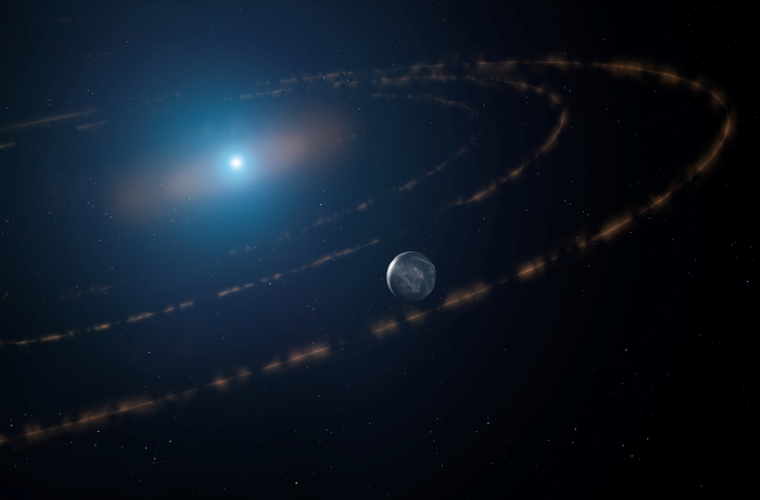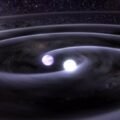The lifespan of the Sun is 12.3 billion years. This is 1.5 billion years shorter than the age of the Universe, 13.8 billion years. If the Sun happened to be born in the first 1.5 billion years of cosmic history, or equivalently at a cosmological redshift above 4 when the first several percent of all stars formed, then it would have turned into a white dwarf by now.
There are about ten billion white dwarfs in the Milky Way galaxy, a few percent of all Sun-like stars that have died by now. This is a result of a coincidence between the lifespan of sunlike stars and the current age of the Universe.
A white dwarf remnant from a Sun-like star is a hot metallic sphere the size of the Earth, containing about 60% of the mass of the Sun. After a few billion years, a white dwarf cools to a surface temperature similar to that of the present-day Sun, about 6,000 degrees Kelvin.
Since a white dwarf is roughly a hundred times smaller in size than the Sun, an observer located at a percent of the Earth-Sun separation, would witness an illumination similar to that on Earth. In such a “habitable zone” around any white dwarf, liquid water could exist on the surface of a rocky planet, enabling the chemistry of life as we know it. Owing to the short orbital time, residents of a habitable planet around a white dwarf would be busy celebrating their birthdays every half a day — the duration of a year in that world.
Over the past decade, a variety of surveys discovered objects blocking the view of white dwarfs. Some white dwarfs show evidence for rocky material in their atmospheres, others in disks of rocky debris or even orbiting very closely — interpreted as the debris of rocky planets that were scattered inwards and disrupted by gravitational tide. Four years ago, a Jupiter-sized planet was discovered in a tight orbit around a white dwarf.
Last week, a team of astronomers led by Keming Zhang announced the announced the discovery of an Earth-mass planet around a white dwarf based on gravitational microlensing. The lensing method of discovery was suggested in a 1992 paper that I wrote with Andy Gould, where the gravity of the planet focuses the light from a distant background star as the planet with its host star passes in front of the source star.
The discovered planet is roughly twice the mass of the Earth and orbits at about twice the Earth-Sun separation. This Earth-mass planet could have started in an initial orbit similar to that of Earth, which expanded later as a result of the mass loss from the Red Giant. This offers hope into the possible survival of the Earth when the Sun will lose mass and expand to a puffed-up Red Giant star in 7.7 billion years, engulfing the current orbit of the Earth with its envelope.
New Earth-mass planets could also form after the death of a Sun-like star, out of the debris left over from the envelope of the Red Giant. If a newly-formed Earth-mass planet orbits closer in, within the habitable zone of the white dwarf, it could block all the stellar light when it transits the line-of-sight that connects the observer to the star. This offers an opportunity to search for artificial illumination of the dark side of the planet. If past civilizations illuminated the planet’s nightside with city lights and left the lights on, then we might notice the artificial lights if their power supply is long lived. A sufficiently illuminated nightside could be detected when the white dwarf is fully occulted.
Given that the luminous surface area of a white dwarf is 10,000 times smaller than that of the sun, absorption features from a planet’s atmosphere during a transit of a white dwarf are much more easily detectable than for sunlike stars. A transit would last a few minutes. Given the proximity of the planet to the star, the transit repetition rate is hundreds of times larger compared to the habitable zone of a Sun-like star. As argued in a 2013 paper that I wrote with Dani Maoz, these circumstances offer the best opportunity for detecting biological signatures, such as molecular oxygen, in the atmospheres of exoplanets. If the planet hosts a technological civilization, one could also search for signs of industrial pollution, like CFC molecules, in the planet’s atmosphere, as suggested in my follow-up paper with Henry Lin and Gonzalo Gonzalez-Abad.
A close-in habitable planet is expected to be tidally locked—showing the same face to the white dwarf, with permanent dayside and nightside. As it turns out, the habitabile distance is dangerously close to the region where the planet would be destroyed by the gravitational tidal force from the white dwarf. Since the habitable zone is not very far from this tidal disruption distance, tides could raise a substantial bulge in any ocean or atmosphere on the planet’s surface.
A tidally locked habitable planet would offer local astronomers the benefit of a permanent nightside where telescopes can be placed to observe their dark sky nonstop. In addition, the white dwarf surface would offer the efficiency of nuclear reactors without creating radioactive waste. By damping trash onto the surface of the white dwarf, one could harvest its gravitational binding energy from the emitted radiation at nearly the yield of nuclear fuel.
All in all, white dwarfs can sustain life long after the progenitor star dies. As catastrophic as the future death of the Sun sounds, the remnant white dwarf could still warm-up our descendants as long as they board a space platform that is located close enough to the fainter furnace. Intelligence can prolong biological life beyond the death of the star that gave birth to it.
Avi Loeb is the head of the Galileo Project, founding director of Harvard University’s – Black Hole Initiative, director of the Institute for Theory and Computation at the Harvard-Smithsonian Center for Astrophysics, and the former chair of the astronomy department at Harvard University (2011-2020). He is a former member of the President’s Council of Advisors on Science and Technology and a former chair of the Board on Physics and Astronomy of the National Academies. He is the bestselling author of “Extraterrestrial: The First Sign of Intelligent Life Beyond Earth” and a co-author of the textbook “Life in the Cosmos”, both published in 2021. His new book, titled “Interstellar”, was published in August 2023.

